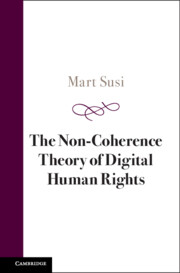Book contents
- The Non-coherence Theory of Digital Human Rights
- The Non-coherence Theory of Digital Human Rights
- Copyright page
- Contents
- Acknowledgements
- Introduction
- Part I The Contextual Challenges and Purpose of the Non-coherence Theory of Digital Human Rights
- Part II Reflections on Some Theories and Doctrines
- Part III The Core Elements of Non-coherence Theory
- 13 Doctrinal Changes in Scope and the Meaning of Human Rights
- 14 The Variance Principle and Digital Transparency
- 15 Legal Certainty and Uncertainty
- 16 On Foreseeability and Non-foreseeability
- 17 Reflections from the Academic Debate
- Part IV The Impact of the Non-coherence Theory
- Part V Internet Balancing Formula
- In Lieu of the Concluding Remarks
- Index
14 - The Variance Principle and Digital Transparency
from Part III - The Core Elements of Non-coherence Theory
Published online by Cambridge University Press: 22 February 2024
- The Non-coherence Theory of Digital Human Rights
- The Non-coherence Theory of Digital Human Rights
- Copyright page
- Contents
- Acknowledgements
- Introduction
- Part I The Contextual Challenges and Purpose of the Non-coherence Theory of Digital Human Rights
- Part II Reflections on Some Theories and Doctrines
- Part III The Core Elements of Non-coherence Theory
- 13 Doctrinal Changes in Scope and the Meaning of Human Rights
- 14 The Variance Principle and Digital Transparency
- 15 Legal Certainty and Uncertainty
- 16 On Foreseeability and Non-foreseeability
- 17 Reflections from the Academic Debate
- Part IV The Impact of the Non-coherence Theory
- Part V Internet Balancing Formula
- In Lieu of the Concluding Remarks
- Index
Summary
Since the digital space enables close to complete transparency, and the perpetuation of the transparency through data storage and not forgetting, it could be said that human rights law measures in the digital domain enable as high a transparency as possible, and have to be given the quality label. This in turn also means that almost anything which the private domain puts forward as self-normativity, and any practice implemented to enhance transparency, would without hesitancy be viewed as positive features. Digital transparency here becomes a shield against any critique of self-normativity and nonaccountability. The higher the degree of supposed transparency and openness in the digital domain, the stronger the immanence that many features remain hidden because in the conditions of ideal transparency the term loses its meaning, and it can only be defined in combination with the opposite. Complete or close to complete transparency has to mean the simultaneous existence of complete or close to complete non-transparency. Since the immanent feature of complete digital transparency is positivity on the surface, there is also non-transparent negativity beneath the surface.
Keywords
- Type
- Chapter
- Information
- The Non-Coherence Theory of Digital Human Rights , pp. 165 - 178Publisher: Cambridge University PressPrint publication year: 2024

